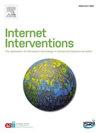Delivering real-time support for self-injury: A systematic review on ecological momentary interventions
IF 4.1
2区 医学
Q1 HEALTH CARE SCIENCES & SERVICES
Internet Interventions-The Application of Information Technology in Mental and Behavioural Health
Pub Date : 2025-04-05
DOI:10.1016/j.invent.2025.100826
引用次数: 0
Abstract
Introduction
Ecological momentary interventions (EMIs) delivered via smartphone apps have gained attention as a potential tool for addressing self-injurious thoughts and behaviors (SITB), particularly non-suicidal self-injury (NSSI). This systematic review aims to assess the efficacy and feasibility of smartphone-based EMIs in reducing SITB and improving mental health outcomes.
Methods
A systematic review was conducted, focusing on smartphone-based EMIs targeting SITB, with particular emphasis on those addressing NSSI. The latest search was made in February 2025.
Results
Sixteen studies featuring smartphone-based EMIs were included. Overall, these studies showed promising evidence for the reduction of SITB. Specifically, several studies reported reductions in NSSI frequency and improvements in emotional regulation among participants. Feasibility and acceptability data showed good results.
Limitations
Key limitations include small sample sizes, study heterogeneity, lack of follow-up, reliance on self-reports, and absence of standardized tools to distinguish NSSI from other self-injurious behaviors.
Conclusions
Results are promising, while the efficacy of smartphone-based EMIs SITB requires further validation through large-scale and well-designed studies. The integration of digital interventions into broader mental health care strategies offers a potential avenue for addressing the treatment gap in at-risk populations, particularly those with limited access to traditional care.
为自残提供实时支持:生态瞬时干预的系统回顾
通过智能手机应用程序提供的生态瞬间干预(EMIs)作为解决自伤思想和行为(SITB),特别是非自杀性自伤(NSSI)的潜在工具而受到关注。本系统综述旨在评估基于智能手机的EMIs在减少SITB和改善心理健康结果方面的有效性和可行性。方法进行了系统评价,重点关注针对SITB的基于智能手机的EMIs,特别强调那些针对自伤的EMIs。最近一次搜索是在2025年2月。结果纳入了16项基于智能手机的EMIs研究。总的来说,这些研究显示了减少SITB的有希望的证据。具体来说,几项研究报告了参与者自伤频率的减少和情绪调节的改善。可行性和可接受性数据均显示出良好的效果。主要的局限性包括样本量小、研究异质性、缺乏随访、依赖自我报告以及缺乏区分自伤与其他自伤行为的标准化工具。结论:基于智能手机的EMIs SITB的疗效需要通过大规模和精心设计的研究进一步验证。将数字干预措施纳入更广泛的精神卫生保健战略,为解决高危人群,特别是那些获得传统护理机会有限的人群的治疗差距提供了一条潜在途径。
本文章由计算机程序翻译,如有差异,请以英文原文为准。
求助全文
约1分钟内获得全文
求助全文
来源期刊

Internet Interventions-The Application of Information Technology in Mental and Behavioural Health
Medicine-Health Informatics
CiteScore
6.50
自引率
9.30%
发文量
94
审稿时长
6 weeks
期刊介绍:
Official Journal of the European Society for Research on Internet Interventions (ESRII) and the International Society for Research on Internet Interventions (ISRII).
The aim of Internet Interventions is to publish scientific, peer-reviewed, high-impact research on Internet interventions and related areas.
Internet Interventions welcomes papers on the following subjects:
• Intervention studies targeting the promotion of mental health and featuring the Internet and/or technologies using the Internet as an underlying technology, e.g. computers, smartphone devices, tablets, sensors
• Implementation and dissemination of Internet interventions
• Integration of Internet interventions into existing systems of care
• Descriptions of development and deployment infrastructures
• Internet intervention methodology and theory papers
• Internet-based epidemiology
• Descriptions of new Internet-based technologies and experiments with clinical applications
• Economics of internet interventions (cost-effectiveness)
• Health care policy and Internet interventions
• The role of culture in Internet intervention
• Internet psychometrics
• Ethical issues pertaining to Internet interventions and measurements
• Human-computer interaction and usability research with clinical implications
• Systematic reviews and meta-analysis on Internet interventions
 求助内容:
求助内容: 应助结果提醒方式:
应助结果提醒方式:


